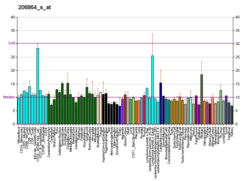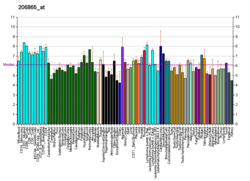HRK (gene)
Activator of apoptosis harakiri is a protein that in humans is encoded by the HRK gene.[3][4]
| HRK | |||||||||||||||||||||||||
|---|---|---|---|---|---|---|---|---|---|---|---|---|---|---|---|---|---|---|---|---|---|---|---|---|---|
| |||||||||||||||||||||||||
| Identifiers | |||||||||||||||||||||||||
| Aliases | HRK, DP5, HARAKIRI, harakiri, BCL2 interacting protein | ||||||||||||||||||||||||
| External IDs | OMIM: 603447 HomoloGene: 136405 GeneCards: HRK | ||||||||||||||||||||||||
| |||||||||||||||||||||||||
| |||||||||||||||||||||||||
| |||||||||||||||||||||||||
| Orthologs | |||||||||||||||||||||||||
| Species | Human | Mouse | |||||||||||||||||||||||
| Entrez |
| ||||||||||||||||||||||||
| Ensembl |
| ||||||||||||||||||||||||
| UniProt |
| ||||||||||||||||||||||||
| RefSeq (mRNA) |
| ||||||||||||||||||||||||
| RefSeq (protein) |
| ||||||||||||||||||||||||
| Location (UCSC) | Chr 12: 116.86 – 116.88 Mb | n/a | |||||||||||||||||||||||
| PubMed search | [2] | n/a | |||||||||||||||||||||||
| Wikidata | |||||||||||||||||||||||||
| |||||||||||||||||||||||||
Function
Activator of apoptosis Hrk regulates apoptosis through interaction with death-repressor proteins Bcl-2 and Bcl-X(L). The HRK protein lacks significant homology to other BCL2 family members except for an 8-amino acid region that was similar to the BCL2 homology domain-3 (BH3) motif of BIK. HRK interacts with BCL2 and BCLXL via the BH3 domain, but not with the death-promoting BCL2-related proteins BAX, BAK, or BCLXS. HRK localizes to membranes of intracellular organelles in a pattern similar to that previously reported for BCL2 and BCLXL.[4]
References
- GRCh38: Ensembl release 89: ENSG00000135116 - Ensembl, May 2017
- "Human PubMed Reference:". National Center for Biotechnology Information, U.S. National Library of Medicine.
- Inohara N, Ding L, Chen S, Núñez G (May 1997). "harakiri, a novel regulator of cell death, encodes a protein that activates apoptosis and interacts selectively with survival-promoting proteins Bcl-2 and Bcl-X(L)". EMBO J. 16 (7): 1686–94. doi:10.1093/emboj/16.7.1686. PMC 1169772. PMID 9130713.
- "Entrez Gene: HRK harakiri, BCL2 interacting protein (contains only BH3 domain)".
- Whitfield J, Harada K, Bardelle C, Staddon JM (Nov 2003). "High-throughput methods to detect dimerization of Bcl-2 family proteins". Anal. Biochem. 322 (2): 170–8. doi:10.1016/j.ab.2003.07.014. PMID 14596824.
- Imaizumi K, Morihara T, Mori Y, Katayama T, Tsuda M, Furuyama T, Wanaka A, Takeda M, Tohyama M (Mar 1999). "The cell death-promoting gene DP5, which interacts with the BCL2 family, is induced during neuronal apoptosis following exposure to amyloid beta protein". J. Biol. Chem. 274 (12): 7975–81. doi:10.1074/jbc.274.12.7975. PMID 10075695.
- Chen L, Willis SN, Wei A, Smith BJ, Fletcher JI, Hinds MG, Colman PM, Day CL, Adams JM, Huang DC (Feb 2005). "Differential targeting of prosurvival Bcl-2 proteins by their BH3-only ligands allows complementary apoptotic function". Mol. Cell. 17 (3): 393–403. doi:10.1016/j.molcel.2004.12.030. PMID 15694340.
Further reading
- Imaizumi K, Morihara T, Mori Y, Katayama T, Tsuda M, Furuyama T, Wanaka A, Takeda M, Tohyama M (1999). "The cell death-promoting gene DP5, which interacts with the BCL2 family, is induced during neuronal apoptosis following exposure to amyloid beta protein". J. Biol. Chem. 274 (12): 7975–81. doi:10.1074/jbc.274.12.7975. PMID 10075695.
- Hartley JL, Temple GF, Brasch MA (2001). "DNA cloning using in vitro site-specific recombination". Genome Res. 10 (11): 1788–95. doi:10.1101/gr.143000. PMC 310948. PMID 11076863.
- Sanz C, Mellstrom B, Link WA, Naranjo JR, Fernandez-Luna JL (2001). "Interleukin 3-dependent activation of DREAM is involved in transcriptional silencing of the apoptotic Hrk gene in hematopoietic progenitor cells". EMBO J. 20 (9): 2286–92. doi:10.1093/emboj/20.9.2286. PMC 125442. PMID 11331593.
- Bae J, Hsu SY, Leo CP, Zell K, Hsueh AJ (2001). "Underphosphorylated BAD interacts with diverse antiapoptotic Bcl-2 family proteins to regulate apoptosis". Apoptosis. 6 (5): 319–30. doi:10.1023/A:1011319901057. PMID 11483855.
- Wakabayashi T, Kosaka J, Hommura S (2002). "Up-regulation of Hrk, a regulator of cell death, in retinal ganglion cells of axotomized rat retina". Neurosci. Lett. 318 (2): 77–80. doi:10.1016/S0304-3940(01)02487-9. PMID 11796190.
- Sanz C, Horita M, Fernandez-Luna JL (2004). "Fas signaling and blockade of Bcr-Abl kinase induce apoptotic Hrk protein via DREAM inhibition in human leukemia cells". Haematologica. 87 (9): 903–7. PMID 12217801.
- Jurisicova A, Antenos M, Varmuza S, Tilly JL, Casper RF (2003). "Expression of apoptosis-related genes during human preimplantation embryo development: potential roles for the Harakiri gene product and Caspase-3 in blastomere fragmentation". Mol. Hum. Reprod. 9 (3): 133–41. doi:10.1093/molehr/gag016. PMID 12606589.
- Whitfield J, Harada K, Bardelle C, Staddon JM (2004). "High-throughput methods to detect dimerization of Bcl-2 family proteins". Anal. Biochem. 322 (2): 170–8. doi:10.1016/j.ab.2003.07.014. PMID 14596824.
- Obata T, Toyota M, Satoh A, Sasaki Y, Ogi K, Akino K, Suzuki H, Murai M, Kikuchi T, Mita H, Itoh F, Issa JP, Tokino T, Imai K (2004). "Identification of HRK as a target of epigenetic inactivation in colorectal and gastric cancer". Clin. Cancer Res. 9 (17): 6410–8. PMID 14695142.
- Sunayama J, Ando Y, Itoh N, Tomiyama A, Sakurada K, Sugiyama A, Kang D, Tashiro F, Gotoh Y, Kuchino Y, Kitanaka C (2005). "Physical and functional interaction between BH3-only protein Hrk and mitochondrial pore-forming protein p32". Cell Death Differ. 11 (7): 771–81. doi:10.1038/sj.cdd.4401418. PMID 15031724.
- Chen L, Willis SN, Wei A, Smith BJ, Fletcher JI, Hinds MG, Colman PM, Day CL, Adams JM, Huang DC (2005). "Differential targeting of prosurvival Bcl-2 proteins by their BH3-only ligands allows complementary apoptotic function". Mol. Cell. 17 (3): 393–403. doi:10.1016/j.molcel.2004.12.030. PMID 15694340.
- Kuwana T, Bouchier-Hayes L, Chipuk JE, Bonzon C, Sullivan BA, Green DR, Newmeyer DD (2005). "BH3 domains of BH3-only proteins differentially regulate Bax-mediated mitochondrial membrane permeabilization both directly and indirectly". Mol. Cell. 17 (4): 525–35. doi:10.1016/j.molcel.2005.02.003. PMID 15721256.
- Certo M, Del Gaizo Moore V, Nishino M, Wei G, Korsmeyer S, Armstrong SA, Letai A (2006). "Mitochondria primed by death signals determine cellular addiction to antiapoptotic BCL-2 family members". Cancer Cell. 9 (5): 351–65. doi:10.1016/j.ccr.2006.03.027. PMID 16697956.
This article is issued from Wikipedia. The text is licensed under Creative Commons - Attribution - Sharealike. Additional terms may apply for the media files.



